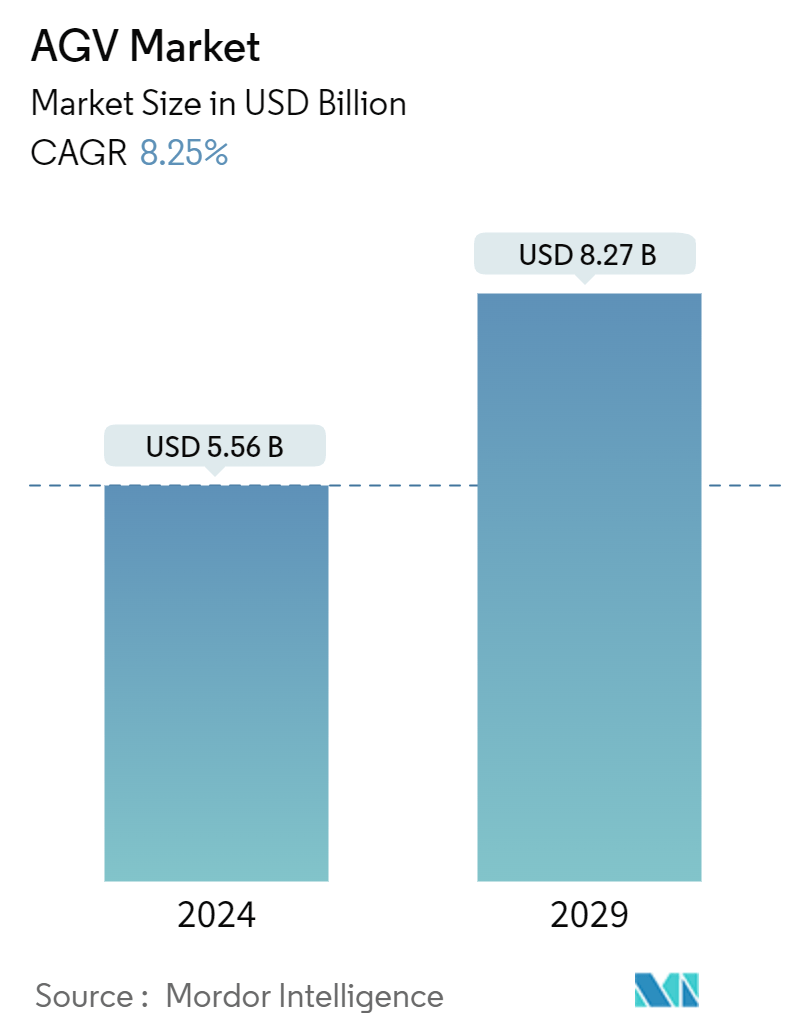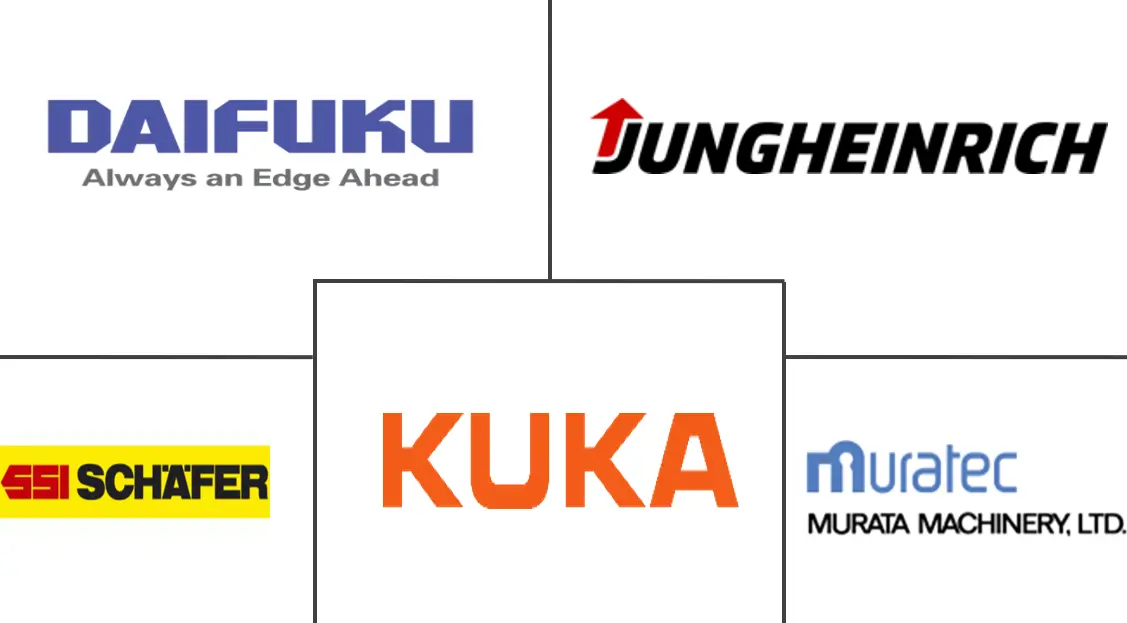Market Size of AGV Industry

| Study Period | 2019 - 2029 |
| Market Size (2024) | USD 5.56 Billion |
| Market Size (2029) | USD 8.27 Billion |
| CAGR (2024 - 2029) | 8.25 % |
| Fastest Growing Market | Asia Pacific |
| Largest Market | North America |
Major Players
*Disclaimer: Major Players sorted in no particular order |
Automated Guided Vehicles Market Analysis
The AGV Market size is estimated at USD 5.56 billion in 2024, and is expected to reach USD 8.27 billion by 2029, growing at a CAGR of 8.25% during the forecast period (2024-2029).
- Rising technological advancements, increased demand for automation in industries, increased demand for robots in manufacturing and warehousing facilities, and growing emerging markets are the key factors driving the growth of the automated guided vehicles market.
- In recent years, automation has revolutionized the manufacturing sector, resulting in enhanced productivity, efficiency, and safety. Among the latest breakthroughs in automation technology are automated guided vehicles (AGVs). AGVs have gained considerable recognition in manufacturing facilities due to their ability to ensure human safety and meet the demand for optimal efficiency. Technological advancements have empowered manufacturers to create AGVs tailored to their operational requirements and effectively implement them for various applications.
- The automotive industry is increasingly incorporating automation and AGVs into its manufacturing floors. For instance, the SEAT plant in Martorell, Spain, is transforming into a digitalized and smart factory. The company implemented AGVs with SLAM navigation, 4G connectivity, and induction battery charging. The facility has eight AGVs for outdoor operation and over 200 AGVs that deliver parts inside the assembly workshops at the Martorell and Barcelona factories.
- The global labor market is extremely tight, which is the primary reason for the growth of automated forklifts. Despite the fact that unemployment is at its lowest level in fifty years, distribution centers and warehouses find it difficult to find and keep trustworthy workers. Automation could provide continuous, reliable performance around the clock, helping to close the labor gap.
- Furthermore, several vendors in the market are focusing on launching AGVs for parking in the buildings, further supporting the market’s growth. For instance, in April 2024, Autech-Otis Parking Systems launched an automatic guided vehicle (AGV) parking robot utilizing artificial intelligence (AI) technology. It is an autonomous driving system that combines AI and Internet of Things (IoT) technologies. Its goal is to automatically find the best routes for self-driving parking lots so that unmanned parking can be made easier.
- The continuously increasing R&D expenditure and the rising number of production establishments worldwide are driving the demand for automation worldwide in mid-range industries, especially in the food processing and pharmaceutical sectors.
- Moreover, companies that automate their supply chains or manufacturing processes with AGVs have to invest a lot of money. This takes care of the price of buying, setting up, and adjusting the workspace to make it more AGV-friendly. Moreover, manufacturers might be dissuaded from using AGVs due to their high cost. Smaller businesses may find it difficult to adopt AGVs since they cannot afford automated systems and must instead use traditional, manual forklift trucks.
- Furthermore, other threats such as recession, inflation, war, climate change, trade disputes, energy access, and industrial espionage are some of the factors that are responsible for directly shaping the role of AGVs in end-user sectors.
Automated Guided Vehicles Industry Overview
Automated guided vehicles (AGVs) are wholly automated transport systems that operate with unmanned vehicles. They offer many advantages, such as reduced operational costs, enhanced workforce safety, and decreased production time. The growing execution of mobile robots worldwide and measures to improve workplace safety and productivity are other factors leading to the adoption of AGVs.
The automated guided vehicle market is segmented by product type (automated forklift, automated tow/tractor/tugs, unit load, assembly line, and special purpose), end-user industry (food & beverage, automotive, retail, electronics & electrical, general manufacturing, pharmaceuticals, and other end-user industries), and geography (North America, Europe, Asia-Pacific, Latin America, and Middle East and Africa). The market sizes and forecasts are provided in terms of value (USD) for all the above segments.
| By Product Type | |
| Automated Fork Lift | |
| Automated Tow/Tractor/Tugs | |
| Unit Load | |
| Assembly Line | |
| Special Purpose |
| By End-User Industry | |
| Food & Beverage | |
| Automotive | |
| Retail | |
| Electronics & Electrical | |
| General Manufacturing | |
| Pharmaceuticals | |
| Other End User Industries |
| By Geography*** | |
| North America | |
| Europe | |
| Asia | |
| Australia and New Zealand | |
| Latin America | |
| Middle East and Africa |
AGV Market Size Summary
The Automated Guided Vehicle (AGV) market is experiencing significant growth, driven by technological advancements and the increasing demand for automation across various industries. The automotive sector, in particular, is integrating AGVs into manufacturing processes to enhance efficiency and productivity. Companies like SEAT and Toyota are leading the charge by implementing advanced navigational technologies and software integrations. The rise of e-commerce has further propelled the demand for AGVs, as warehouses seek to improve order fulfillment efficiency and manage large volumes of stock-keeping units with greater accuracy. The COVID-19 pandemic has accelerated this trend, highlighting the need for automation in warehouses to maintain operations and streamline supply chains.
The Asia-Pacific region stands out as the largest consumer of AGVs, with China leading due to its robust manufacturing industry and adoption of Industry 4.0 technologies. The region's fragmented market allows for affordable automation solutions, driving further adoption. Emerging markets like India are also witnessing a surge in e-commerce, prompting increased deployment of AGVs in warehouses. Key players in the market, such as Amerden Inc. and Swisslog Holding, are continuously innovating and expanding their product offerings to meet the growing demand. Collaborations and partnerships among companies and research institutions are fostering advancements in AGV technology, ensuring the market remains competitive and dynamic.
AGV Market Size - Table of Contents
-
1. MARKET INSIGHTS
-
1.1 Market Overview
-
1.2 Industry Value Chain Analysis
-
1.3 Industry Attractiveness - Porter's Five Forces Analysis
-
1.3.1 Bargaining Power of Suppliers
-
1.3.2 Bargaining Power of Buyers/Consumers
-
1.3.3 Threat of New Entrants
-
1.3.4 Threat of Substitute Products
-
1.3.5 Intensity of Competitive Rivalry
-
-
1.4 Impact of COVID-19 Aftereffects and Other Macroeconomic Factors on the Market
-
-
2. MARKET SEGMENTATION
-
2.1 By Product Type
-
2.1.1 Automated Fork Lift
-
2.1.2 Automated Tow/Tractor/Tugs
-
2.1.3 Unit Load
-
2.1.4 Assembly Line
-
2.1.5 Special Purpose
-
-
2.2 By End-User Industry
-
2.2.1 Food & Beverage
-
2.2.2 Automotive
-
2.2.3 Retail
-
2.2.4 Electronics & Electrical
-
2.2.5 General Manufacturing
-
2.2.6 Pharmaceuticals
-
2.2.7 Other End User Industries
-
-
2.3 By Geography***
-
2.3.1 North America
-
2.3.2 Europe
-
2.3.3 Asia
-
2.3.4 Australia and New Zealand
-
2.3.5 Latin America
-
2.3.6 Middle East and Africa
-
-
AGV Market Size FAQs
How big is the AGV Market?
The AGV Market size is expected to reach USD 5.56 billion in 2024 and grow at a CAGR of 8.25% to reach USD 8.27 billion by 2029.
What is the current AGV Market size?
In 2024, the AGV Market size is expected to reach USD 5.56 billion.

